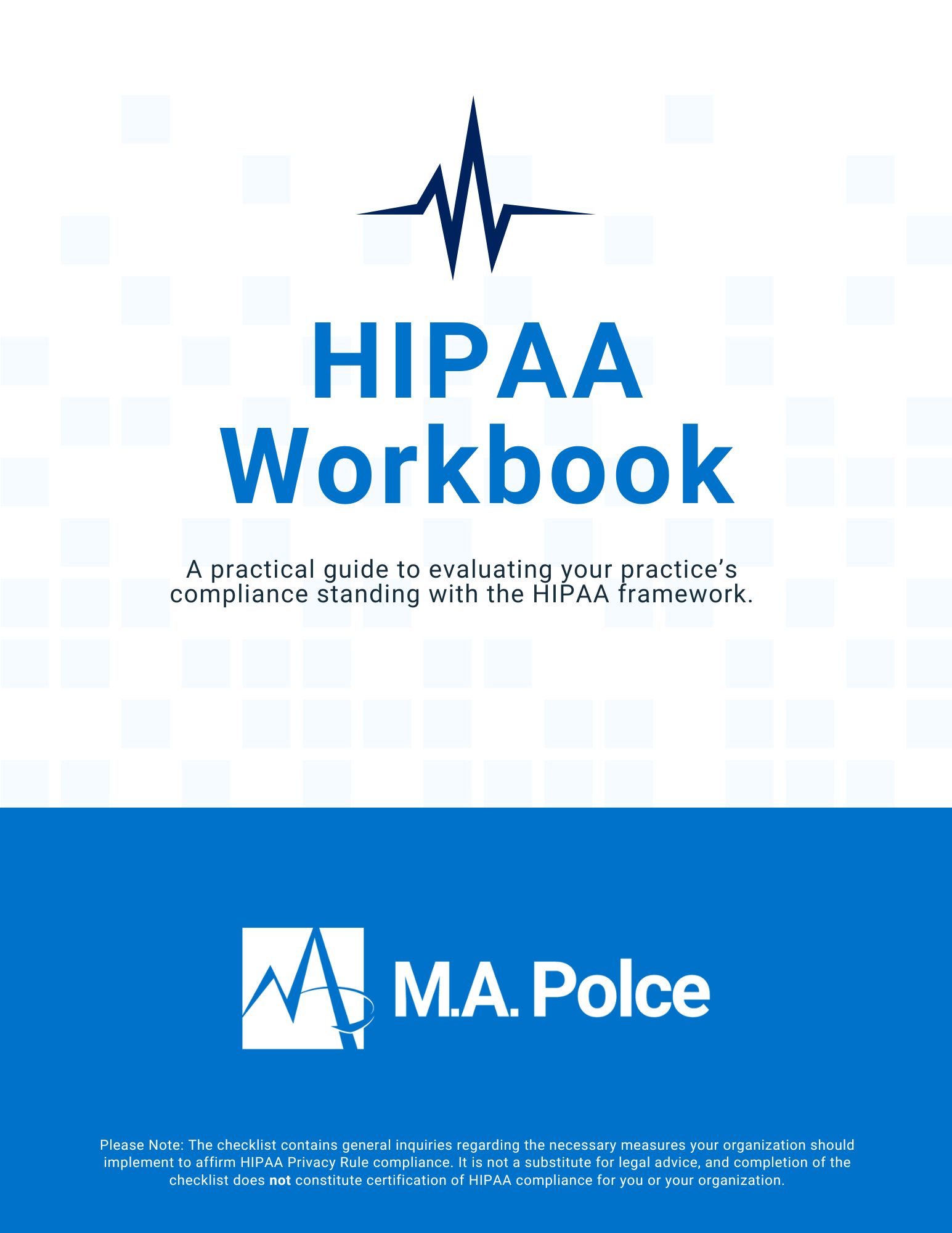Is HIPAA Compliance Enough?
In the ever-evolving landscape of digital era healthcare, the safeguarding of patient data stands as an imperative. While the Health Insurance Portability and Accountability Act (HIPAA) has long been regarded as the gold standard for protecting sensitive health information, a pressing question looms large: Is HIPAA compliance enough?
Compliance ≠ Security
HIPAA sets a baseline for protecting sensitive patient data within the healthcare industry, but it’s important to recognize that compliance alone may not guarantee robust cybersecurity. Why?
Because compliance frameworks like HIPAA set minimum standards rather than comprehensive security measures. While compliance mandates adherence to specific rules and regulations, it may not address all potential vulnerabilities or emerging cyber threats.
Cyber attackers are constantly evolving their tactics, and as a result, compliance standards can lag behind in addressing new risks or technologies.
Additionally, compliance focuses on meeting specific requirements rather than fostering a proactive, risk-based approach to cybersecurity. Therefore, organizations solely relying on compliance may overlook critical security gaps or fail to adapt to evolving cyber threats, leaving them vulnerable to breaches and other security incidents.
For this reason, healthcare companies with a genuine interest in enhancing their security posture should view HIPAA compliance as a starting point and consider adopting more comprehensive frameworks like the National Institute of Standards and Technology Cybersecurity Framework (NIST CSF).
What is the Purpose of HIPAA?
HIPAA regulations serve the purpose of safeguarding the privacy and security of protected health information (PHI) within the healthcare industry. The primary objectives of HIPAA include:
- Protecting Patient Privacy: HIPAA regulations establish standards for the use and disclosure of PHI, ensuring that patients have control over their health information and that it is only accessed by authorized individuals for permissible purposes.
- Securing Health Information: HIPAA mandates security measures to safeguard electronic PHI (ePHI) from unauthorized access, alteration, or destruction. This includes implementing administrative, physical, and technical safeguards to protect the confidentiality, integrity, and availability of PHI.
- Facilitating Healthcare Transactions: HIPAA includes provisions to standardize electronic healthcare transactions, such as claims processing and payment, to improve efficiency and reduce administrative burdens within the healthcare system.
What is the Purpose of the NIST CSF?
Meanwhile, the NIST CSF serves a broader purpose beyond specific industry regulations like HIPAA. The primary objectives of the NIST CSF include:
- Providing a Risk-Based Approach: The NIST CSF offers a risk-based framework that enables organizations to assess and manage cybersecurity risks effectively. It helps organizations prioritize their cybersecurity efforts based on their unique risk profiles and business objectives.
- Promoting Comprehensive Cybersecurity Practices: The NIST CSF covers various aspects of cybersecurity across five core functions: Identify, Protect, Detect, Respond, and Recover. It provides guidance on cybersecurity governance, risk management, security controls, incident response, and resilience.
- Facilitating Continuous Improvement: The NIST CSF promotes a culture of continuous improvement by encouraging organizations to regularly assess their cybersecurity posture, identify areas for enhancement, and implement best practices to mitigate cybersecurity risks.
While HIPAA regulations focus specifically on protecting health information within the healthcare industry, the NIST CSF offers a more complete approach to cybersecurity that is applicable across various sectors.
The NIST CSF provides organizations with a flexible and adaptable framework for addressing cybersecurity risks, aligning with industry standards, and promoting continuous improvement in cybersecurity practices. Therefore, the NIST CSF is considered more comprehensive than HIPAA regulations, as it provides a broader and more adaptable framework for managing cybersecurity risks beyond regulatory compliance requirements.
HIPAA vs. NIST CSF
Here are the key differences between HIPAA requirements and the NIST Cybersecurity Framework, along with reasons why NIST is considered more comprehensive:
Scope and Flexibility
- HIPAA requirements primarily focus on protecting the privacy and security of protected health information (PHI) and are specific to the healthcare industry.
- The NIST Cybersecurity Framework is broader and applicable to organizations across various sectors. It provides a flexible, risk-based approach to cybersecurity that can be customized to suit the specific needs and risk profiles of different organizations.
Risk Management Approach
- HIPAA compliance mandates certain security measures but does not provide detailed guidance on risk management or mitigation strategies.
- The NIST-CSF emphasizes risk management principles, encouraging organizations to identify, assess, and prioritize cybersecurity risks. It provides a structured framework for developing risk-based cybersecurity programs tailored to an organization’s unique risk landscape.
Comprehensive Guidance
- HIPAA compliance standards are prescriptive, outlining specific requirements that organizations must meet to achieve compliance.
- The NIST CSF offers comprehensive guidance across five core functions: Identify, Protect, Detect, Respond, and Recover. In other words, it provides organizations with a framework for assessing their current cybersecurity posture, establishing goals, and implementing best practices to address cybersecurity risks effectively.
Continuous Improvement
- HIPAA compliance is often viewed as a checkbox exercise, with organizations focusing on meeting minimum requirements to achieve compliance.
- The NIST Cybersecurity Framework promotes a culture of continuous improvement, encouraging organizations to regularly assess and refine their cybersecurity practices based on evolving threats, technology changes, and organizational priorities.
Alignment with Industry Standards
- While HIPAA compliance aligns with specific regulations governing healthcare data, it may not fully align with broader cybersecurity best practices or industry standards.
- The NIST CSF is widely recognized and aligned with other industry standards and frameworks, making it easier for organizations to integrate with existing cybersecurity practices and initiatives.
Overall, while HIPAA compliance is essential for healthcare organizations handling PHI, adhering to the NIST Cybersecurity Framework offers a more inclusive and adaptable approach to cybersecurity that goes beyond mere compliance, promoting a proactive and risk-based approach to protecting sensitive data and mitigating cybersecurity threats.
Can the NIST CSF Help with Achieving HIPAA Compliance?
Entities subject to HIPAA can achieve compliance more effectively with the help of NIST CSF, which complements HIPAA regulatory requirements in many ways.
Risk Assessment and Management
- HIPAA Requirement: HIPAA mandates that covered entities conduct a risk analysis to identify potential risks and vulnerabilities to the confidentiality, integrity, and availability of protected health information (PHI).
- NIST CSF Integration: The NIST CSF provides a structured approach to risk assessment and management, aligning with HIPAA’s requirement. It offers detailed guidance on identifying, assessing, and prioritizing cybersecurity risks across various organizational assets and processes. By using the NIST CSF framework, covered entities can enhance their risk management practices, ensuring a more thorough evaluation of cybersecurity risks beyond what HIPAA’s requirements explicitly outline.
Security Controls Implementation
- HIPAA Requirement: HIPAA requires covered entities to implement administrative, physical, and technical safeguards to protect PHI, including access controls, encryption, and audit controls.
- NIST CSF Integration: The NIST CSF provides a catalog of security controls organized into five core functions: Identify, Protect, Detect, Respond, and Recover. Covered entities can leverage the NIST CSF’s detailed guidance on security controls to help implement the necessary safeguards required by HIPAA. For example, the Protect function offers guidance on access control, data encryption, and other measures to safeguard PHI, while the Detect function provides guidance on implementing monitoring and audit controls to detect unauthorized access or breaches.
Incident Response and Recovery
- HIPAA Requirement: HIPAA mandates that covered entities develop and implement procedures for responding to and reporting security incidents involving PHI, as well as establishing contingency plans for data recovery.
- NIST CSF Integration: The NIST CSF emphasizes incident response and recovery as critical components of cybersecurity resilience. It offers guidance on developing incident response plans, conducting post-incident analysis, and improving recovery capabilities. By adopting the NIST framework, covered entities can enhance their incident response and recovery capabilities, ensuring a more effective and coordinated response to security incidents involving PHI, thereby meeting HIPAA requirements more exhaustively.
Continuous Monitoring and Improvement
- HIPAA Requirement: HIPAA encourages covered entities to regularly review and update their security measures to address evolving threats and vulnerabilities
- NIST CSF Integration: The NIST CSF promotes a culture of continuous improvement by providing guidance on establishing cybersecurity policies, procedures, and metrics for ongoing monitoring and evaluation. Covered entities can use the NIST CSF to establish mechanisms for continuous monitoring, performance measurement, and regular cybersecurity assessments. By doing so, they can ensure that their security measures remain effective and aligned with evolving threats and regulatory requirements. This facilitates compliance with HIPAA’s mandate for continuous improvement.
By integrating the NIST CSF into their cybersecurity practices, HIPAA-covered entities can address the shortcomings of HIPAA requirements by enhancing their overall risk management capabilities, implementing more robust security controls, improving incident response and recovery processes, and fostering a culture of continuous improvement. The alignment between the two can make achieving and maintaining HIPAA compliance less challenging, providing covered entities with a complete and adaptable framework for managing cybersecurity risks effectively.
Run a Practice that Is Both Compliant and Secure
In conclusion, while HIPAA compliance is critical for protecting sensitive patient data, it is merely a starting point.
Healthcare companies looking to enhance their security posture should consider adopting more comprehensive cybersecurity frameworks like the NIST Cybersecurity Framework. The NIST CSF provides a flexible and adaptable approach to cybersecurity that can be customized to suit the specific needs and risk profiles of different organizations, promotes a culture of continuous improvement, and aligns with industry standards. By implementing the NIST CSF, organizations can go beyond regulatory compliance requirements and significantly improve their cybersecurity posture.
If your organization needs help navigating cyber risk management and compliance, particularly if it is subject to HIPAA requirements, consider partnering with an IT services provider such as M.A. Polce. Whether you already have an established team and require assistance with specific aspects of HIPAA requirements or if you’re starting from scratch and need to build a comprehensive compliance program from scratch, M.A. Polce offers tailored solutions to meet your needs. We provide a range of services designed to accommodate healthcare organizations at any stage of their compliance journey. Contact us today to learn more about how we help healthcare practices across New York State just like yours.




